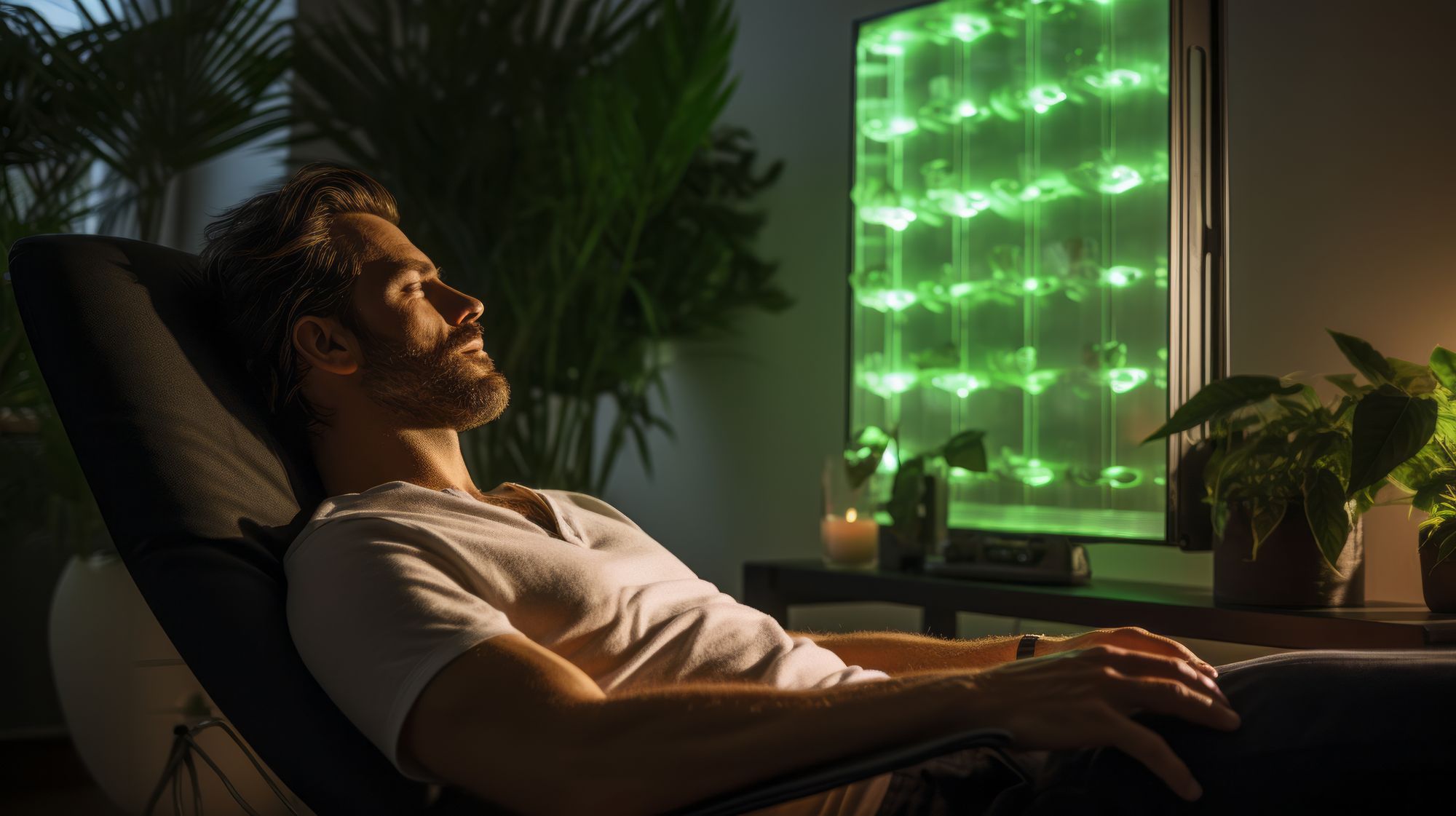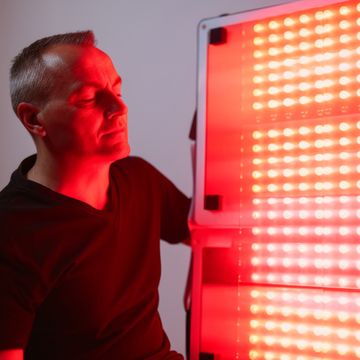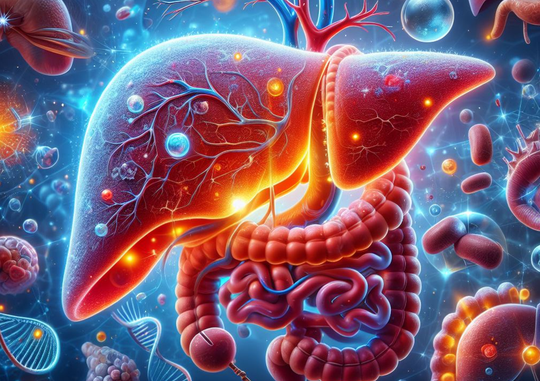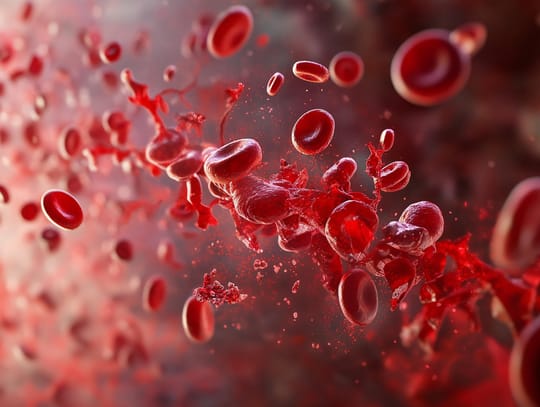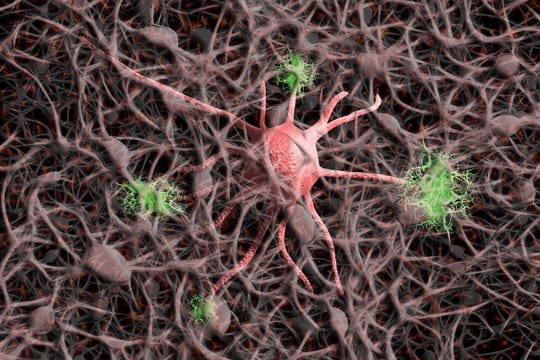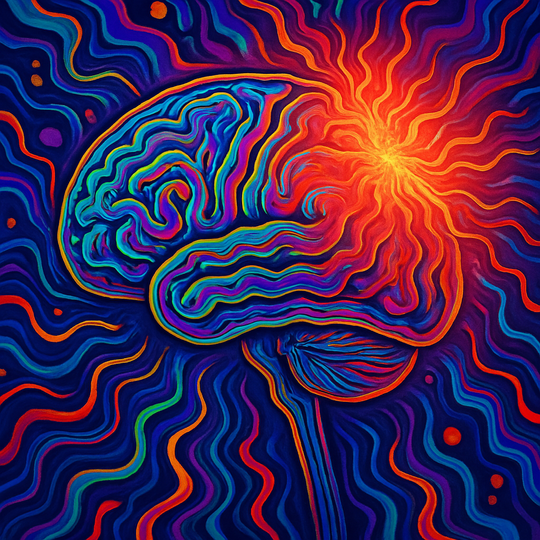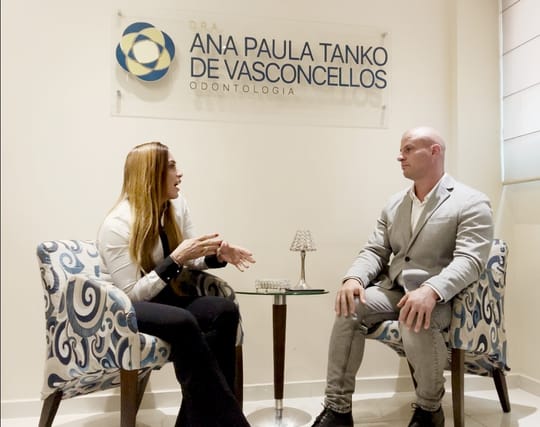In this blog post, I'll look at green light therapy. You may know that red light therapy has become extremely popular recently, and blue light therapy has also been introduced in the light therapy space.
Red light therapy has tons of all-round health benefits, such as lowering inflammation, reducing pain, beautifying your skin, hair, nails, increasing athletic and cognitive performance, enhancing sleep quality, and more. Blue light therapy has benefits for mood and skin quality.
So, you might also be curious about the benefits of green light therapy. I dug to dig deep into the green light therapy science. I consulted the light therapy database by Vladimir Heiskanen and searched for the term "green light" in there. The studies categorized as "green light" I then read and summarized in the blog post below.
Green Light Therapy Effects Summary
- I found around 80 studies on green light therapy in total. Some studies were surprisingly promising and showed green light therapy benefits in humans.
- The best evidence for green light therapy effects in humans currently exists in the area of countering pain, promoting fat loss, impeding cellulite, and boosting muscle mass and blood circulation.
- Other effects that are only established in animal or laboratory (in vitro) studies show promises for skin health, wound healing, immune system benefits, the proliferation and differentiation of stem cells, ligament repair, dental benefits, anti-tumour effects, and more, although evidence is really flimsy in these areas right now.
- Some green light therapy products currently exist. Examples here are the Hooga green light therapy / color therapy product (code ALEX saves), and an anti-migraine light bulb by Hooga as well
- I'd love to see some tabletop panels that emit common green light therapy wavelengths such as 520nm, 532nm, and 570nm for pain, for instance, or even full body panels for fat loss, circulation, and muscle mass gains. Whether these tabletop or full body panels work well remains to be seen, of course!
- Overall, the science of green light therapy is extremely promising after looking at most published literature and I expect many new findings emerge once thousands of studies are carried out as there are on red and near-infrared light, because many green light studies do show a biological effect.
Green Light Therapy Introduction
So what is green light? From a physics perspective, green light is part of the light spectrum (1; 2: 3). And that light spectrum, in turn, is part of the electromagnetic spectrum. You can see that green light below:
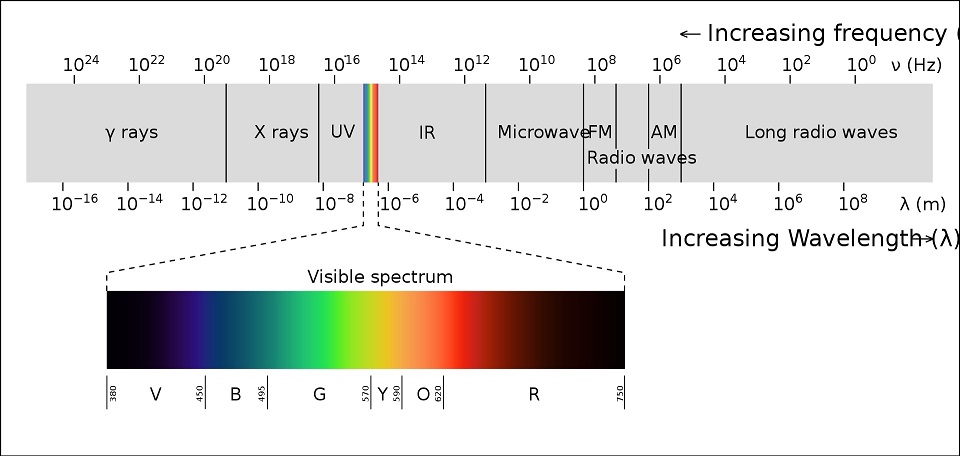
CC BY-SA 3.0 Lisence, created 6 Aug 2007 by Philip Ronan
If you can read that picture well, you'll see that green light has a wavelength between 495 and 570 nanometers long. That green light is visible to the naked human eye and appears green to you as the name already tells. For context, infrared light (which feels hot) and ultraviolet light (which can give you a sunburn and creates vitamin D in your skin) are invisible, and you cannot see them without scientific instruments.
But, all colors of the rainbow, including green light, are visible to the naked human eye. And, it turns out that this light doesn't just give you the ability to see. Instead, light, when it hits your skin, affects human biology. As stated before, blue light benefits skin health, mood, and other domains. And the benefits of red light are almost too countless to mention here. So the natural question is, "what does green light do?". I'll explore that question in the next section.
Green Light Therapy Science & Green Light Therapy Benefits
Below I've broken down all the green light therapy science in more detail. I used the light therapy database by Vladimir Heiskanen and found 102 hits on that search term. I decided to only consider studies that specifically study the 495 - 590 nanometer wavelength. I know 570 - 590 isn't technically green light but Vladimir has included it in the "green light" category sometimes. And, these definitions where exactly one color of light starts and the other ends isn't based on objective criteria anyway, which is why that approach is justifiable, in my opinion.
Right off the bat, I will say that the research on green light therapy is very flimsy. Not only is there not a lot of research, but much of the research is also either in animals or laboratory settings (with cell cultures). So, whatever findings I describe below, almost all of it needs to be confirmed in high-quality human research.
Nevertheless, what we know from the red light therapy and blue light therapy space is that lots of positive animal research also translates into positive human research.
So here's the green light therapy science - the potential green light therapy benefits that yet have to be confirmed in human studies.
1. No Effect On Alzheimer's Disease
A 2022 study exposed mice to different types of light, including green light at 500nm, near-infrared light, and far infrared (4; 5). Only far infrared light worked on cleaning up beta-amyloid plaques, which are posited as the main cause of Alzheimer's disease. Inflammation went down with the far infrared light exposure while energy production in the cell increased. These effects weren't found from exposure to green light.
The researchers speculate that the far infrared might penetrate deeper and therefore have a more profound effect.
2. May Improve Skin Health
In vitro laboratory studies investigated the effects of different light types on "endothelial cells proliferation" (6). Endothelial cells are skin cells. When comparing 475nm blue, 516nm green, and 635nm red light, the 516nm green light had the greatest effects. Keep in mind that I'm talking about an in vitro study here in a laboratory, with cells derived from an umbilical cord. These effects thus need to be confirmed in high-quality trials with humans instead of cell cultures. Nevertheless, the researchers of the 2017 study write:
"The treatment with blue light was ineffective. Several parameters showed that green light was even more potent to stimulate proliferation and migration of endothelial cells than clinically well-established red light therapy. Further studies have to focus on intracellular mechanisms induced by different wavelengths in order to optimize this promising therapy in tissue regeneration." (6)
So, green light therapy may have more skin health benefits than even blue light in some domains.
Another study had a similar setup, comparing different blue, green and red light therapy on umbilical cord cells (11).
In this case, 630nm red light was most effective. Not only did the 630nm red light have a better effect than 595nm green light (which might actually be "yellow" or "amber") but it also had better effects on Nitric Oxide (NO). NO plays a significant role in blood flow. As a result, researchers state that 630nm light may work to counter erectile dysfunction, which has similar underlying mechanisms. But, the 595nm light just had fewer effects here, there wasn't a complete absence of an impact.
In one more study, green light lowered inflammation in the skin (29). Different cytokines (messenger cells that influence inflammation) were affected, such as TNF-alpha, Interleukin-6, and Interleukin-8.
3. May Improve Wound Healing
An animal study compared 460nm blue light, 530nm green light, and 700nm red light for the creation of fibroblasts in the skin (7). Fibroblasts play a major role in connective tissue and the extracellualar matrix (the area between cells), and also play a role in wound healing (8; 9).
In this study, rodents either received LED therapy or didn't. A 10 J/cm2 dose was used. If you want to learn more about that topic, read my red light therapy dosing guide. The rodents received light therapy for seven days, every other day. On day eight the rodents were killed.
The outcome?
Both the red and the green LED groups had significant increases in fibroblast counts. The blue light therapy group didn't have any benefit over the control group that didn't receive light treatment.
Another study also investigated the effects of different LEDs and a laser on fibroblasts (10). The laser emitted 830nm near-infrared light while different LED configurations at 570nm green light, 660nm red light, and 950nm near-infrared light were used. The light therapy was aimed at cell cultures, not animals or humans. But, the results are fascinating, as the green light yielded more fibroblasts than the alternatives of red and near-infrared light. The researchers were investigating these effects for wound healing, once again, so the implication here is that green light therapy might stimulate wound healing even better than red light will.
Different studies show wound healing benefits in mice too (63; 68). The same is true for in vitro studies (67).
In other studies, green light doesn't activate stem cells like red light (52; 57; 58; 62). In this study, using stem cells derived from fat tissue and irradiating it with red, blue, and green light, only red showed positive effects and led to likely improvements in scar healing, tissue repair, and so forth. Other studies using 532nm light did show results in this regard (53; 54; 55; 56; 59; 60). Inflammation was lowered and the wound-healing capacity of the stem cells increased. Stem cell proliferation and differentiation may also improve.
4. Alters Red Blood Cell Physiology And Your Body's Blood Circulation
Next up, blue and green light were used on red blood cells by using lasers (12). Red blood cells play a major role in how well your blood circulation works. If red blood cells aggregate too much, the "microcirculation" at the lowest level might be impeded, for instance. Blue light was used at 450nm here and green light at 520nm. The researchers state:
"The results revealed that high radiant exposure (over 170.5 J/cm2 radiant fluence) caused enhanced [Red Blood Cell (RBC] aggregation and cell shape transformation while the aggregation force between single RBC remained unchanged. LLLR with radiant fluence below 9.5 J/cm2 by 450 nm wavelength improved the RBC deformability, weakened the strength of cell-cell interaction in the RBC disaggregation process, and showed rejuvenating effects on RBC suspended in a harsh cell environment." (12).
In this case, only the blue light arguably has positive effects, at lower power densities (9.5 J/cm2). Extremely high doses that are 2-3X the normally prescribed dose for red light therapy, cause the aggregation of red blood cells.
Unfortunately, there's no free full text of the study available, so I can't look deeper into the effects of the green light here.
But, on the upside, more studies on green light and circulation are available (13; 14). This study from the year 2000 investigated the effects of blue and green light on blood flow. Back then, researchers didn't believe that so-called "photoreception" existed outside the eye. But, as was shown in this study, blue light at 410 - 420nm, green light at 540 - 550nm, and green light at 570 - 580nm do improve circulation.
Nitric Oxide (NO) is once again the mechanism here. The researchers know that NO is the mechanism here because the results disappeared when they injected the rats with medication that affects NO.
So, from this rat study, green light at 540 - 550nm and 570 - 580nm influences blood flow in the skin.
In another study, smooth muscle cells were irradiated with 532nm lasers, which is also green light (15).
Smooth muscle cells are found all across the body, such as in the intestines and in blood vessels (16; 17). The result of the laboratory in vitro study was that the 532nm light affected the apoptosis of cells (programmed "cell death" of cells that no longer function well), and inhibited the proliferation of smooth muscle cells, and their migration. This outcome can be viewed as positive though as atherosclerosis ("narrowing of the blood vessels") is often caused by excessive smooth muscle proliferation and not enough apoptosis.
Anther in vitro study confirms this result (18).
So, 532nm green light may play a role in preventing the thickening of coronary arteries and other blood vessels, by balancing the creation of new smooth muscle cells (which cause narrowing if the process is excessive), and the killing of defect cells (apopotosis).
In a wound-healing study with rats, green light at 520nm also increased the creation of blood vessels more than red or blue light (78). However, the dose was extremely high, at 240 J/cm2. This study also showed that green light might be very beneficial to wound healing once again. Other studies confirm this finding (80; 81). Specifically, a reduction in wound healing in diabetic wounds might be reversed. In another study though, red and near-infrared light outperformed green light at 520nm and 570nm for wound healing (79). So the jury is still out.
5. Increases Fat Loss
A recent 2020 study investigated the effects of 532nm green light on fat loss (18; 19). Sixty overweight adults participated in the study. Participants received twelve light therapy treatments either spread out over a four-week period, six weeks, or during 12 weeks. The researchers state the following about the achieved fat loss:
"When comparing across treatment groups, the greatest reductions from baseline were observed in those assigned to twice weekly for 6 weeks in weight (1 ± 1.7 (±SD) kg by week 6), waist circumference (- 2.0 ± 3.2 in. by week 6 and - 1.5 ± 3.2 in. by week 26), body mass index (- 0.4 ± 0.6 kg/m2), and body fat mass (- 1.1 ± 1.6 kg). This group also had the most significant improvement from baseline in quality of life (+ 0.5 ± 0.8 by week 6), body satisfaction (+ 0.2 ± 0.4 by week 6 and week 26), and body appreciation (+ 0.2 ± 0.3 by week 6 and + 0.3 ± 0.3 by week 26). LLLT twice weekly for 6 weeks could be proposed as the optimal frequency and duration for the management of body weight. " (18).
The 532nm light was a laser. So, the biweekly treatment protocol worked best with that 532nm laser and did lead to fat loss, most importantly. The laser used in this study, the The Erchonia® Zerona™ 2.0 Laser, is even FDA-approved for fat loss according to the full text of the study and very explicitly uses green light, not red light (19). I'm emphasize that statement because I'm a bit surprised myself on this outcome, as I didn't know about this effect.
What's also interesting is that the three-times-per-week treatment group didn't receive any benefits over baseline. Weight, BMI, or waist circumference didn't decrease in this group. In the two times per week group, 25% of participants received a 3% weight reduction, without changing their lifestyle or exercise habits. The biweekly group improved BMI, waist circumference, and weight. Participants were overweight at the start of the study though, so you may not receive these benefits if you have a healthy body weight.
Nevertheless, this ability to improve fat loss in overweight people is extremely interesting. And, there's another fat loss study using 532nm green light (19).
Let's explore that study. This time, people who are overweight or obese were included. Participants either received a real treatment with 532nm green light or a sham treatment that merely looks like you're receiving a treatment (for placebo control). The treatment group received three weekly treatments for a four-week period.
Of the treatment group, 71% lost inches on their body circumference (no full text available, so I cannot check how these inches were measured, although they were measured at the hips, waist, and upper abdomen), while 12% in the sham treatment group did. Once again, an FDA-approved device was used - green light therapy for body contouring.
6. Reduces The Appearance Of Cellulite Extremely Effectively
Once again, more human evidence that green light works. This time, the effect of 532nm light on cellulite was investigated (20). Half of 60+ participants received a sham treatment here and the other half a real treatment. About 56% of the treatment group improved their cellulite while that number was only 9% in the sham treatment group. Only three weekly sessions were used for two weeks in the treatment group. The appearance of cellulite, measured with the "Nurnberger-Muller grading scale", on the hips and buttocks decreased. Those areas are most commonly affected with cellulite (21). Most participants in the treatment group said they were satisfied or very satisfied.
An added bonus? The treatment group also reduced their bodyweight, further adding to the thesis that green light therapy is great for fat loss.
7. Might Promote Muscle Growth
I go back to animal studies, unfortunately (21). In a study, baby chicks were irradiated with either blue, green, red, white (which should contain all colors) light. There was also a darkness group. Here was the outcome:
" The proliferation of satellite cells isolated from the [green]-group was highest, and in vivo green light remarkably increased the number of proliferating cell nuclear antigen (PCNA)-positive cells in skeletal muscle. Meanwhile, plasma IGF-1 was higher (15.5-16.2%) in the [green]-group than that in [darkness]- and [red]-groups, and the satellite cells isolated from the G-group had a more sensitive response to IGF-1." (21).
The wavelength or exact treatment protocol isn't listed, unfortunately. It's interesting though that green light stimulates IGF-1 or "Insulin Like Growth Factor", which play a major role in the maintenance and increase of muscle mass (22; 23; 24). The same is true for satellite cells (25; 26).
More human research is needed though before it can be established that green light therapy works for muscle mass gains and growth.
In anther study using rats, green light improved muscle tension maintenance while red and blue light didn't (39). In that study, 405nm, 532nm green, and 808nm near-infrared light were compared. The 808nm group helped the recovery from muscle hardness though. Blue light had no effect. While extremely rudimentary, I think this effect needs to be investigated in humans as well, to see whether 532nm green light affects workout performance.
8. May Promote Hair Growth
One more super interesting green light therapy study - this time on promoting hair growth (27). A very low dose was used at 0.2 J/cm2 on mice, but, with a microneedle so the effective dose was probably higher than if the dose was applied on the skin. It turned out that 513nm green light worked better than 629nm red light. And, red light, right now, is considered the gold standard for hair loss treatments, such as with androgenetic alopecia. The number of hair follicles increased, as well as new blood vessels were formed under the skin, and collagen structures improved in the skin near the hair follicles.
9. May Protect Against Carbon Monoxide Toxicity
Visible light and green light in particular can apparently protect you against carbon monoxide poisoning (28). This effect is only demonstrated in rats though - no humans were harmed for research. In this study, 460nm blue light, 523nm green light, and 623nm red light were used. What happens is that the visible light disassociates the carbon monoxide from the hemoglobin in the blood. That hemoglobin normally carries oxygen but when it's affected by carbon monoxide, oxygen is no longer carried throughout the body and you'll die eventually. The visible light increased carbon monoxide removed by two to threefold.
10. May Affect The Immune System
A study from the year 2000 looked at different visible light as well as near-infrared light wavelengths (30). Both human cell cultures as well as mice were treated. For the green light therapy, 532nm light was used again.
In the mice which were treated with a toxin, the natural killer cells' and murine bone marrow cells' activity improved after a few different visible light wavelengths including green light. Calcium metabolism in lymphocytes - which play a role in the lymphatic system - were affected in human cells. Green and red light showed positive benefits here, while near-infrared didn't.
I would take these results with a grain of salt right now though, as it's a single study that needs to be confirmed in larger high-quality human trials.
11. May Affect Inflammatory Processes In The Joints, Such As With Rheumatoid Arthritis
Rheumatoid arthritis is an autoimmune condition where inflammatory processes degrade your joints and cartilage tissue over time. A 2014 study investigated the effects of green light at 570nm and near-infrared light at 940nm in mice (31). The knee joint of the mice was treated three times per week for an eight-week period.
And, while the results from 940nm light were more positive than that of 570nm light, the green light still had a positive effect. So, the 570nm light still had an inhibitory response on the inflammation of Rheumatoid Arthritis. But as always, I want to see human confirmation of these results, even though they are promising.
12. May Protect Organ Function, Such As In The Kidneys Or Liver
Once again, I'm looking at a mice study (32). The 405nm, 532nm, and 635 nm were compared for their effect on organ function. After treatment with one of these wavelengths, different outcomes were measured in the mice. These outcomes were the activity of the mitochondria (the energy-producing factories of your cells), how well cell proliferate, the cleaning up of non-functioning cells, and inflammatory markers.
All three wavelengths promoted mitochondrial activity. And, green light also increased cell proliferation and growth factors. The other wavelengths had other benefits. The researchers conclude:
"Specific wavelengths of laser energy appear to induce different responses in renal fibrotic tissue. These findings support further study in the development of a customized laser therapy program of combined wavelengths to optimize MSC effects in the treatment of renal fibrosis." (32).
As always, human studies are needed.
Next up, there's a study on liver regeneration in rats (34). Different light types were used, such as 410nm and 470nm blue light, 512 green light, 590nm yellow light, and 630nm red light. Vladimir Heiskanen, who quotes the full text of the study, summarizes the outcome as follows:
"[Blue, green and yellow light had more pronounced effects on State 3 and 4 respiration than the red light, which didn't have a statistically significant effect]"
So, apparently green light can have an effect on liver regeneration as well.
13. May Increase The Repair Speed Of Ligaments
Ligaments connect bones and hold your body together. People have ligament injuries all the time, such as in the ankle and shoulder. The knee is another common area where ligaments are affected, and the ACL, or "anterior cruciate ligament" is one of the most frequently affected. In this study, ACL repair was measured in rabbits after using different wavelengths of light (33). This study tested 460nm blue light, 530nm green light, and 630nm red light. Blue and green used a dose of around 10 J/cm2 and the blue light group a dose of 27 J/cm2.
The result?
Cell proliferation of both the red and green light groups improved. Blue light didn't lead to any results. IGF-1, which I talked about before in this blog post, and collagen, also went up in the red and green light groups. In some regards, the blue light group did worse. All in all, the following conclusion was drawn by the researchers:
"This study revealed that irradiation with a wavelength of 460 nm (blue LED) is cytotoxic to ACL cells, but irradiation with nontoxic fluencies of 530 (green LED) and 630 nm (red LED) wavelengths induced cell growth in cultured ACL cells." (33).
Once again, this study is promising but we need a lot more human confirmation.
14. May Not Affect Energy-Production Directly Like Blue And Red Light Do
Several studies looked at how green light affects mitochondrial function. Remember that the mitochondria are the "energy-producing factories" of your cell. The scientific consensus is that red light specifically increases Adenosine Triphosphate (ATP) production, the main current of energy - although I may not agree with that thesis. Blue light, moreover, is sometimes negative in how it influences energy production at the cellular level.
In terms of green light, studies exist but the outcome so far is that nothing happens (35; 36; 37). Some studies do show an effect but don't compare the effect to blue or red, which is generally greater in most studies (38; 47).
15. May Have Anti-Tumor Effects
I don't want to say too much here as I don't want people to be using green light therapy as a cancer treatment. Having said that, in some very basic in vitro laboratory studies, green light seems to have an anti-tumor effect at very high dosages (40; 41; 43; 44). Cancer cell proliferation may also be affected by different types of light. Some of the studies even show benefits of blue light here!
16. May Affect Dental Health
Preliminary researchs shows that green light therapy benefits dental health on many different levels, such as:
- In a 2021 study, the effects of 532nm green light on dental stem cells was investigated (45). Stem cells are the primordial general cells in biology, that can differentiate into many different cells with specific functions. Stem cell proliferation did improve, as well as wound healing.
- Root resorption that was induced by inflammation, after moving teeth in rats, was reduced with green light (46). Green, red, and near-infrared light all had positive effects. Bone structure was best in the green light group overall.
17. May Improve Male Fertility
Green light at 532nm improves the mobility of fish sperm, depending on the dose (48). The same is true for green light between 490nm and 540nm in rats (49).
18. Doesn't Protect Against Lung Injury Due To Sepsis (Blood Poisoning)
In a rat study, red light but not green light was protective against sepsis (blood poisoning) (50). Green light at 520nm was used and red light at 660nm. The lung injury was induced by the sepsis in the rats. For nerds, the researchers write the following about the effects of the red light therapy:
"Red LED treatment reduced neutrophil influx and the levels of interleukins 1β, 17 A and, tumor necrosis factor-α; in addition to enhanced levels of interferon γ in the bronchoalveolar fluid. Moreover, red LED treatment enhanced the RNAm levels of IL-10 and IFN-γ. It also partially reduced the elevated oxidative burst and enhanced apoptosis, but it did not alter the translocation of nuclear factor κB, the expression of toll-like receptor 4 (TLR4), as well as, oedema or mucus production in their lung tissues. Together, our data has shown the beneficial effects of short treatment with LED on [Acute Lung Injury] that are caused by gram negative bacterial infections. It is suggested that LED applications are an inexpensive and non-invasive additional treatment for sepsis." (50).
19. Likely Affects Inflammation
When comparing 465nm blue light, 525nm green light, and 645nm red light, all of them can inhibit inflammation in cells of a degenerative disc in the spinal cord (51). This is an in vitro study though, so should be taken with a grain of salt unless more human data becomes available.
20. Extends Lifespan In Fruit Flies
While not so important for humans, green light extended the lifespan of fruit flies (61). The foods in the study or the microbiota may have been affected by that green light. Blue light inhibited lifespan though (I hypthesize because it wasn't paired by red or near infrared light as in nature). However, the value of this study is quite limited as there's no human evidence for this thesis.
In other studies, green light lowers free radical production which is also intertwined with aging (64; 65; 66). In some studies though, regeneration is impeded with green light (77).
21. Lowers (Chronic) Pain And Promotes Relaxation
Both green and red light affect the glutamate and GABA system in chicks (69). Glutamate and GABA concern excitation and relaxation. Green light here, may counter pain on a fundamental level. Especially nerve pain may be affected here.
Other studies confirm green light's effect in pain, potentially referring to human studies that I didn't come across myself (70). Unfortunately, I couldn't get free access to the full text of this study. However, the researchers write in the abstract of the study:
"Green light therapy has been shown to be effective in reducing chronic pain in humans and rodents. However, its underlying mechanisms remain incompletely defined. In this study, we demonstrate that green light exposure reduced postsurgical hypersensitivity in rats. Moreover, this therapy potentiated the antinociceptive effects of morphine and ibuprofen on mechanical allodynia in male rats. Importantly, in female rats, GLED potentiated the antinociceptive effects of morphine but did not affect that of ibuprofen. We showed that green light increases endogenous opioid levels while lessening synaptic plasticity and neuroinflammation. Importantly, this study reveals new insights into how light exposure can affect neuroinflammation and plasticity in both genders. Clinical translation of these results could provide patients with improved pain control and decrease opioid consumption. Given the noninvasive nature of green light, this innovative therapy would be readily implementable in hospitals." (70).
That outcome is obviously extremely promising. Another study confirms this viewpoint in rats (71). Fortunately, that study did provide a free full text, which then allowed me to a full text for free. So here's what I found:
First, green light exposure to the eyes least likely causes migraines in rats when that light enters the eyes( 72). So, compared to other forms of light exposure, green has been found to be safest. Fortunately, this effect is confirmed in humans too (74). The exposure to normal white light was compared to green light in that study setup. White light reduced headache days by 66% in people who had headaches some of the time and 50% in people with chronic headaches. No side effects were reported. Also, the quality of life was improved in the human participants as well as a reduction in the intensity of the headaches.
Another study tried to investigate why green light has this effect on migraines (76). Here, the sensitivity of the retinal pathway is used as the explanation as to why green light is less likely to cause migraines than white light, and why it is almost certainly healing even.
Secondly, in humans, there's strong evidence that green light also impedes pain with fibromyalgia (73). Here too, white and green light were compared and green light had far superior effects for pain reduction. The mechanism by which that pain reduction occurs is currently unknown though, although, the full texts of the study I quoted earlier clears that mechanism up a bit (71; 74). Endogenous opioid system stimulation plays a likely role, meaning, that you're creating internal painkillers. Beta-endorphins, natural opioids that are responsible that you get for a "runner's high", for instance, are much higher after green light exposure in the brain - and for nerds: specifically the cerebrospinal fluid. Enkephalins are also increased and have a similar function.
The problem here, is that in both studies, on migraines and fibromyalgia, participants were exposed to 1-2 hours per day during the study.
Next up, there's another rat study that uses green light for pain (75). After exposure to green light, rats withdrew their paws less quickly, after being exposed to a painful stimulus. The good news here is that the pain-reducing effect lasted for four days, even after the therapy had halted. So there's a long-term effect, at least in rats. For nerds, moreover, there's the following explanation as to why the eyes probably play a major role in this phenomenon:
"Rats fitted with green contact lenses exposed to room light exhibited antinociception arguing for a role of the visual system. Antinociception was not due to stress/anxiety but likely due to increased enkephalins expression in the spinal cord. Naloxone reversed the antinociception, suggesting involvement of central opioid circuits. Rostral ventromedial medulla inactivation prevented expression of light-induced antinociception suggesting engagement of descending inhibition. Green LED exposure also reversed thermal and mechanical hyperalgesia in rats with spinal nerve ligation. Pharmacological and proteomic profiling of dorsal root ganglion neurons from green LED-exposed rats identified changes in calcium channel activity, including a decrease in the N-type (CaV2.2) channel, a primary analgesic target. Thus, green LED therapy may represent a novel, nonpharmacological approach for managing pain." (75).
So, after green light exposure to the eyes, the levels of painkilling enkephalins are affected in the spinal cord. This effect can be reversed through medication. And, green light becomes a promising intervention for anti-pain therapies, especially when also given through the eyes, not just the skin.
So Does Green Light Therapy Work?
After going through 80 studies, I can say for a fact that green light therapy works. In a few areas, good human studies are available, making it extremely likely that there's an effect here. These green light therapy effects are:
- Countering different types of (chronic) pain
- Boosting blood circulation
- Enhancing fat loss
- And likely increasing muscle mass, speeding up wound healing, and improving skin quality.
Many other effects exist as well, but merely in animal and in vitro studies. But, in total, only 80 different studies are available on green light therapy and not thousands such as is the case with red and near-infrared light. To me, it's extremely likely that many other effects will be found once more studies are available, given that most studies that are currently published do show an effect. Of course, we need black-and-white confirmation for that first.
Then, let me zoom out a bit next. Overall, the fact that green light has many effects, and blue light does, and red light and near infrared light do, and far infrared does, and different types of UV light do, has solidified my opinion that sunlight is extremely important for health because you get all wavelengths from there, not just isolated wavelengths in an LED panel. The fact that green light has many effects on health makes more much more certain of that thesis, once again.
Next up, let's look at some green light therapy device and what I'd like to see in this market:
Best Green Light Therapy Devices & What I Wish To See
So far, not many companies offer green light therapy. The reason is probably that most companies aren't convinced about the green light therapy effects in the current science, because almost nobody went through most of the published science on this topic before, as far as I know.
But, Hooga is one company that currently offers some smaller green light therapy devices. First, Hooga offers a very small spot treatment green light therapy device that you can see below:
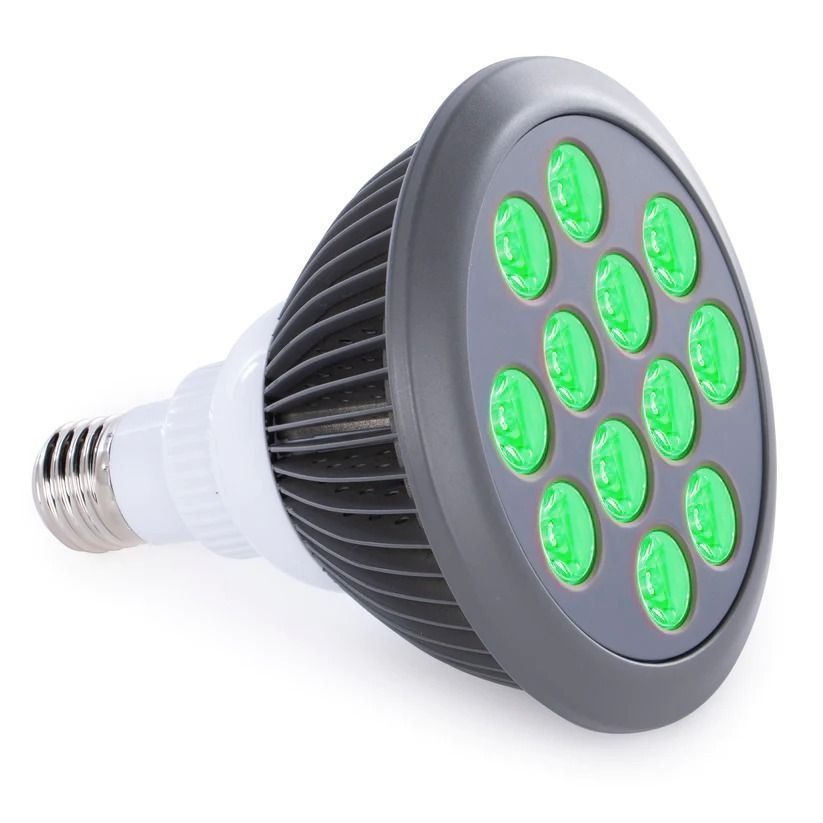
You can order the Hooga green light therapy spot treatment device by going to the Hooga website, clicking "more products", then "color therapy", and then selecting the green spot treatment device. Discount code ALEX saves on the Hooga website.
Also, Hooga offers an E26 green light therapy bulb for migraines, that can be used next to your computer, for instance, but only at Amazon:
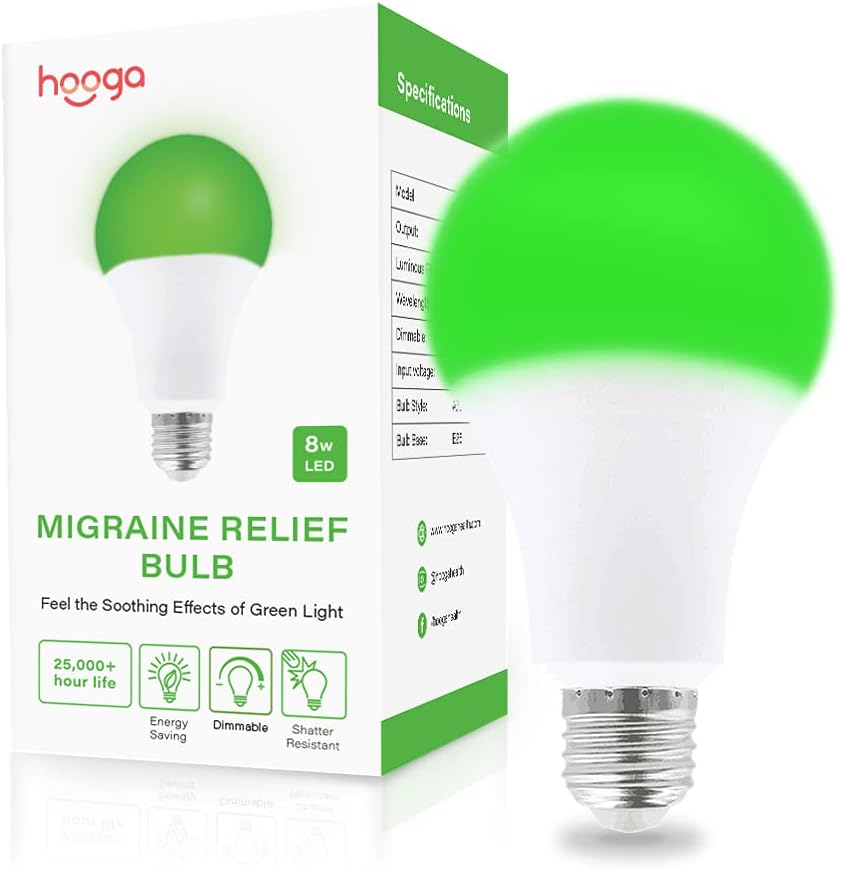
If you look at the Amazon reviews of this E26 light bulb, you can see that people are generally very happy with the product, although it's a bit of a hit or miss - not everyone has success for migraines.
In the past, LightpathLED also had some panels that emitted green light but I can no longer see them on their website. So, basically there's only one company that we regularly review products of that currently sells green light therapy products.
But what would I like to see? At the very least, I'd like to see some tabletop panels with common green light therapy wavelengths, such as 520nm, 532nm, and 570nm green light. And, if people have great results with a tabletop green light therapy device, I'd like to see a full body panel even, to observe what the results for muscle mass, fat loss, pain, and blood circulation are, as well as other effects that people might experience that have not been studied yet.
Hopefully, after writing this blog post, "red" light therapy companies will soon start offering the option of green light therapy as well. PlatinumLED kind of shocked the industry in 2022 by adding blue light therapy to their BioMax panels. This process could be similar.
Finally, let's conclude:
Conclusion: Green Light Therapy Is Promising But A Lot More Human Research Is Needed
Hopefully you're convinced the green light therapy science is really exciting. As you can see, many different green light effects exist. I'll fully expect other bloggers to start talking about these effects in the future, as it was just last year that a big player in the red light therapy space - PlatinumLED - started expanding to blue light therapy. That choice opens the possibility that other wavelengths of light are to be included.
Of course, there are many unknowns. For instance, I'd like far more data on the exact wavelengths, their difference, the best power output of green light therapy, how frequently to dose, and so forth. So, you and I are back to trial and error, just as the red light therapy space was in 2015 or so. Back then, we didn't even have a good intuitive understanding of how full-body panels worked. Now we do and scientific confirmation keeps trickling in as well.
Good times are coming for light therapy...
Items Mentioned
- Hooga reen light therapy device - discount code ALEX saves 10%
- Hooga green E26 light bulb - discount code ALEX saves 10%

